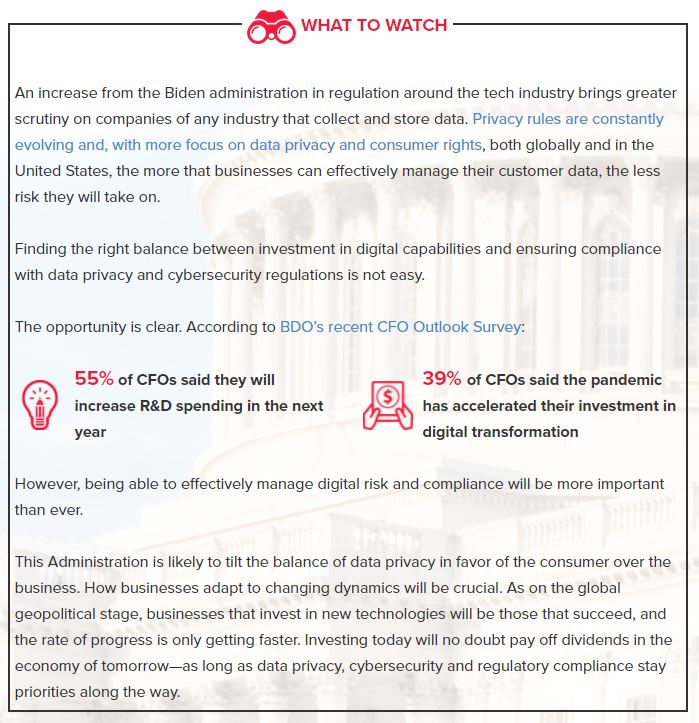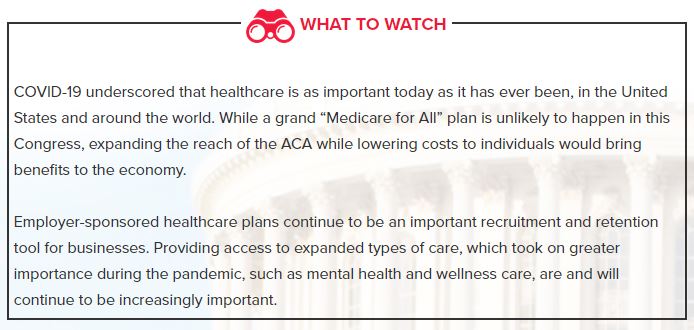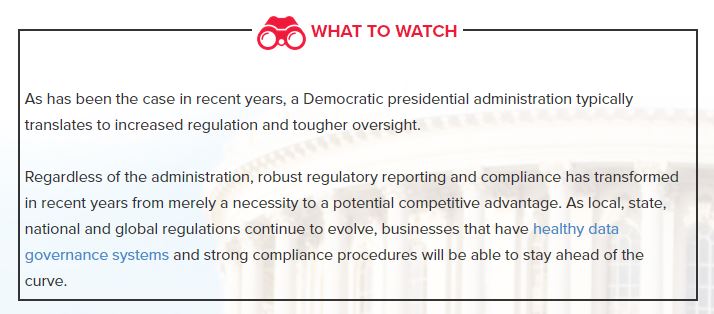During the first three months in office, the Administration has been able to accelerate vaccination distribution after a record-speed vaccine development process, offering hope of a world less impacted by the spread of the pandemic.
However, with 100 days now in the rearview mirror, the Biden administration is setting its sights on the future—one in which the United States still faces both short- and long-term challenges that would be daunting for any administration. From continuing to chip away at a COVID-heightened unemployment rate to addressing domestic and social unrest to thinking through a climate change strategy, the Administration has its hands full over the next few years. With a challenging midterm election on the horizon, the motivation to advance its agenda quickly and decisively is top of mind.
For business leaders, the intersection between politics, economy, consumer behavior, public health, social issues, and environmental issues has never been so large—or important. Businesses will continue to be tested in ways that they could not have imagined just a few years ago. Those that can navigate these challenges well will come out ahead.
While there are dozens of policies that will unfold over the next four years, there are several key areas for leaders to watch in the short term and consider for future opportunities and challenges that arise.
Priority: Putting the Pandemic Behind Us
When the American Rescue Plan Act (ARPA) was passed in March, it offered a re-upping of the stimulus—nearly $6 trillion worth in total—that the U.S. economy has been leaning on for support since the pandemic began. The $1.9 trillion ARPA relief plan centered on stimulus checks, expanded unemployment support, expanded paid sick leave, emergency paid leave, reimbursements to small businesses, funds for state and local governments, and resources for vaccination programs and testing sites.This has been the priority for the Biden administration. If the Administration can continue to oversee a successful rollout of vaccinations, the idea is that everything else will fall into place. While the Biden administration moved quickly to juggle multiple priorities in its first 100 days, the faster and more successfully the vaccination rollout goes, the faster the economy can put the COVID-19 lockdowns behind it—and move on to what’s next.
Priority: Doing Well by Doing Good
Beyond tackling the pandemic, one of President Biden’s next highest priorities is around promoting broad environmental, social, and governance (ESG) initiatives.
On the environmental front, battling climate change has been a central pillar of President Biden’s campaign, starting with reentering the Paris Agreement hours after he took office through a series of executive orders that placed climate change at the forefront of domestic and foreign policy. President Biden has intrinsically tied his climate policy to his plan for economic recovery, promising a move towards a “Clean Energy Revolution.”
The Administration’s goals are lofty. Included in his $2 trillion proposed climate proposal are plans to:- Eliminate fossil fuel emissions entirely from the energy sector by 2035 and in the economy more broadly by 2050.
- Reengineer old infrastructure to be able to endure the effects of climate change.
- Encourage electric vehicles and the system of charging stations that would keep them running.
- Expand zero-emission public transportation.
- Invest in eco-friendly buildings and housing construction.
- Improve sustainable agriculture practices.
- Develop new technologies for clean energy.
In addition to the focus on climate change, the Biden administration has made it clear that it will embrace further mandatory regulatory requirements around ESG reporting broadly.
The first step for regulators will be deciding upon a reporting framework designed to provide more consistent, comparable, and reliable information for investors. Establishing the baseline will help businesses better understand, report, measure, and track against key metrics more easily and consistently.
In March, the SEC launched a Climate and ESG Task Force in a concerted effort to encourage businesses to improve corporate practices around environmental, gender, racial and social issues. Consistent with increasing investor focus and reliance on climate and ESG-related disclosure and investment, the Task Force will also develop initiatives to proactively identify and address ESG-related misconduct.
|
For many boards, the issue of ESG has moved its way up the shareholder meeting agenda in recent years. As sustainability becomes standard and more scrutiny is put on action versus talk, boards are focusing more attention than ever before on issues of diversity, equity, inclusion, and environmental stewardship.
|
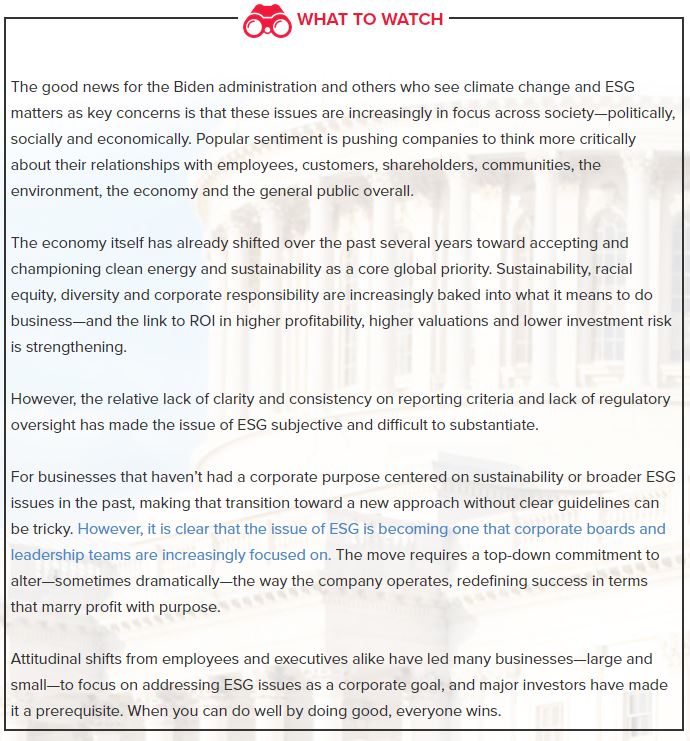
|
More than ever before, people want to work for organizations that stand for clear values. Whether around racial justice, gender equity, environmental protection, wealth equity, or any other cause, businesses are learning to get the most out of their workforces by leading by example. Read more about What’s Next for Work: The Intersection of People, Purpose, and Pivots. |
Priority: Innovation in the Spotlight
The Biden administration inherited a country that is more reliant on technology than ever before. From technologies that have helped large parts of the economy run remotely for a year to those that kept us connected in isolation to those that have helped towards solving the pandemic itself, the trends in how businesses are using technology have accelerated years within the space of months.
There is no doubt that the technology sector has, by and large, benefitted from these changes. At the same time, the Biden administration appears to have an increasingly scrutinous eye on Big Tech’s influence, leaning into a bipartisan effort to put guardrails up around the country’s largest tech firms—in many cases, guardrails that technology leaders themselves are on the record as welcoming.
The United States’ reliance on technology brings enormous opportunities but also vast vulnerabilities in the form of antitrust concerns, cybersecurity, and privacy threats, in addition to malevolent uses of social media for purposes of spreading misinformation.
As Biden considers a permanent nominee to the Federal Communications Commission, whoever ends up sitting in that role will have important implications for the Tech community, ensuring that while innovation occurs, it is done with what’s best for the greater good in mind.
The push and pull between innovation and risk is continual, and businesses—both in the technology industry and those that rely on technology—will have to contend with increasing regulatory guidelines to better manage the true impact that these technologies have on the economy and on society.
|
Privacy laws are constantly evolving around the world and in the United States, at both a statewide and federal level. |
Priority: Defining Bidencare
The healthcare industry has been in the spotlight for the past decade, since the Affordable Care Act was signed in March 2010. After numerous lawsuits and challenges, including in the U.S. Supreme Court, the ACA is set to be bolstered in the Biden administration. The President has already used executive orders to expand enrollment periods for the ACA in an effort to strengthen the program in the short term before turning his eye to his vision of Bidencare.
What might Bidencare include? In short, it will build on the ACA, focusing on lowering premiums, deductibles, and the price of prescription drugs, while expanding access and adding a public option. The Biden administration was even able to secure boosts to the ACA within the COVID-focused ARPA, in the form of a removal of the income cap for health insurance premium tax credits through a federal exchange or state marketplace, as well as a limit of 8.5% of income for healthcare costs.
What Bidencare is unlikely to include, however—at least in the current political climate—is a sweeping change to the industry.
While the Biden administration has been able to use multiple tools to make progress on priorities such as pandemic response and battling climate change, any major changes on the immediate future of healthcare in the United States remain in doubt.
Interactive: Building Long-Term Resilience
There were many regulatory, legislative, and compliance-related changes that occurred during the pandemic, including several stimulus options, new compliance considerations, and an expectation of new and updated regulatory guidance.
Click here to see the full Resilience Agenda.
Priority: Building Back Better
On the campaign trail, then-candidate Biden outlined his vision of an infrastructure plan dubbed the “Build Back Better” plan.
The new bill, announced in full in late March as the American Jobs Plan, includes several proposed investments in both traditional and modern infrastructure systems.
 Roads & bridges |
 Public Transport |
 Ports |
 Airports |
 Nationwide electric vehicle charging grid |
 Water Systems |
 Electric Grid Upgrades |
 Increased Broadband Access |
In addition, President Biden is pushing for investment in care for elderly and disabled Americans, new affordable housing and schools, and funding for manufacturing, R&D, and job training.
The Biden administration has argued that decades of a lack of investment has left the United States lagging behind others when it comes to competitiveness on the global stage. In particular, the Administration sees this as an opportunity to level the playing field, financing more projects in rural and disadvantaged communities, with a focus on sustainability and “clean infrastructure” investments.
Infrastructure is often seen as a “both sides-of-the-aisle” issue, yet an agreement has recently been hard to come by. Whether President Biden and his team—particularly Vice President Kamala Harris and Transportation Secretary Pete Buttigieg—will be able to galvanize both sides of the aisle to come together on this shared goal of fixing the widely acknowledged problem of the United States’ aging infrastructure remains to be seen.
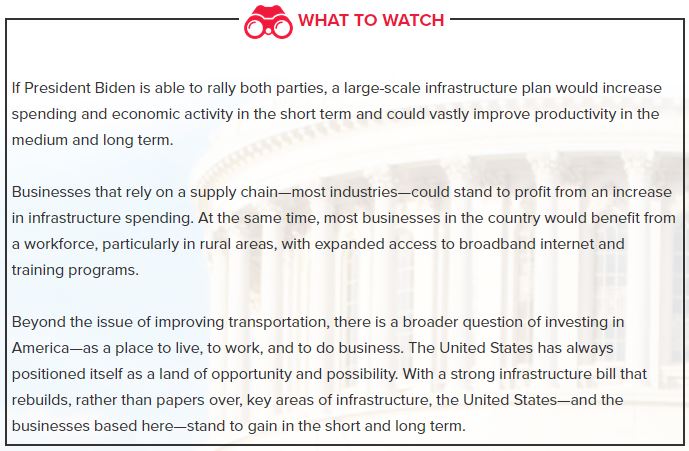
Priority: Tax Increases on the Table
President Biden has made it clear that he is willing to consider raising individual, corporate, and capital gains marginal tax rates, along with tax treatments of other issues such as pass-through entities, estate taxes, and gift taxes, in part to help offset costs of the ARPA and other priority spending packages. During the campaign, he floated raising taxes on those making $400,000 per year and above, in addition to increasing corporate taxes from 21% to 28%.
Tax rates have been a hotly discussed topic since the 2017 Tax Cuts and Jobs Act (TCJA) was passed without bipartisan support. However, while Democrats control the White House and both chambers of Congress, it remains difficult—but not impossible—to see a standalone tax reform bill passing through the Senate due to filibuster rules. The use of the Budget Reconciliation procedures to pass tax legislation, therefore, continues to be a point of discussion.
However, the Biden administration is finding ways to make progress against their tax goals. Included within the ARPA were what resulted in several tax hikes, such as removing deductions for wealthy individuals and corporations as Congressional Democrats sought to balance certain tax cuts—for example, waiving taxes on unemployment benefits.
“All eyes will be on Washington the next couple of years as the Biden administration and this Congress move to advance their tax policy through the various means available to them. Regardless of what tax policy looks like by the midterm elections, one thing is clear: the need for a strategic tax function is more evident than ever. The potential advantages to a strong approach to local, state, federal and international taxes are huge—the tax department should be seen as a strategic center for every organization.”
– Matthew Becker, BDO National Managing Partner of Tax
In addition, the corporate tax rate increase to 28% proposed as part of the infrastructure plan will no doubt be the subject of great debate in Congress as well. Whether the final infrastructure bill includes this exact tax change remains to be seen. Regardless, there will be other opportunities for the Biden administration to introduce incremental change in tax policy, but the future of sweeping legislative reform is still uncertain.
|
The 2021 BDO Tax Outlook Survey, which polled senior tax executives at middle-market companies, outlined key takeaways on the tax landscape. Highest priorities:
Percentage of tax executives who believe the U.S. federal corporate tax rate will increase within the next year: 92%
|

|
For a deeper view into the legislative path to tax reform under a Biden Administration, including a look into the different potential ways that tax changes could take shape, read BDO's guide here. |
Priority: Regulating Wall Street
The Biden administration wasted no time in establishing its stance on regulation of the financial services industry, appointing Gary Gensler as head of the Securities and Exchange Commission and Rohit Chopra to direct the Consumer Financial Protection Bureau. Both Gensler and Chopra have already signaled their intent for increased oversight and enforcement.
In general, the Biden administration aims to be more aggressive in enforcement over the financial sector than his predecessor. While the Federal Reserve and the Department of the Treasury may play the most high-profile roles in the financial markets during the next four years, particularly on the topic of setting interest rates and issuing government debt, respectively, other agencies such as the SEC, the CFPB, the CFTC and others will take steps to increase enforcement of financial regulation.
Businesses are being tasked at the moment with navigating a challenging economic recovery while at the same time performing a duty to their customers, their communities, and the environment around them. Understanding the political landscape and priority policies of this Administration will help executives make better decisions about their own futures in the short and long term.
“The challenges of the past year have brought with them enormous opportunities for businesses to embrace change, transform themselves in new and better ways, and lead with purpose with an eye towards the future. What exactly a post-pandemic economy looks like remains to be seen, but the organizations that thrive tomorrow will be those that emphasize innovation, compassion, resilience and purpose today.”
- Wayne Berson, BDO CEO
With the ARPA signed into law and the vaccine rollout well underway, the Biden administration has already shifted gears from pandemic response to its other priorities. With a midterm election quickly approaching, President Biden and his allies in Congress will want to make as much progress as possible over the next two years—and businesses should be prepared for swift movement in ESG, innovation, infrastructure, tax policy, and other areas of focus.
However, whether President Biden is able to make progress on everything he has set out to accomplish remains to be seen. In a hyper-partisan environment, one where the pendulum may soon—potentially as early as 2023—swing back to a divided government, compromise is rare, and trust in the federal government is at historical lows. When progress is slow, leaders step up to fill the void—and that leadership role may ultimately fall to the private sector.
Businesses can—and should—play a role in driving the change they want to see. Over the course of the Biden administration, corporate policy should be shaped not only by new rules and regulations but by the pursuit of a higher purpose.
For more information about the above article or other business advisory services, contact Marty Williams, CPA, at (334) 887-7022 or by leaving us a message below.
This article originally appeared in BDO USA, LLP's Insights/Tax/Federal Tax - May 2021. Copywrite 2021 BDO USA, LLP. All rights reserved. www.bdo.com.



